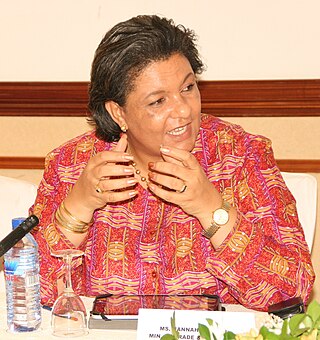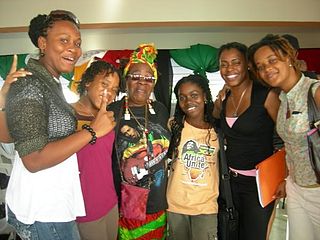
Sexism is prejudice or discrimination based on one's sex or gender. Sexism can affect anyone, but it primarily affects women and girls. It has been linked to gender roles and stereotypes, and may include the belief that one sex or gender is intrinsically superior to another. Extreme sexism may foster sexual harassment, rape, and other forms of sexual violence. Discrimination in this context is defined as discrimination toward people based on their gender identity or their gender or sex differences. An example of this is workplace inequality. Sexism may arise from social or cultural customs and norms.
Marital rape or spousal rape is the act of sexual intercourse with one's spouse without the spouse's consent. The lack of consent is the essential element and need not involve physical violence. Marital rape is considered a form of domestic violence and sexual abuse. Although, historically, sexual intercourse within marriage was regarded as a right of spouses, engaging in the act without the spouse's consent is now widely classified as rape by many societies around the world, and increasingly criminalized. However it is repudiated by some more conservative cultures.
Gender equality, also known as sexual equality or equality of the sexes, is the state of equal ease of access to resources and opportunities regardless of gender, including economic participation and decision-making; and the state of valuing different behaviors, aspirations and needs equally, regardless of gender.

The roles of women in Hungary have changed significantly over the past 200 years. Historically, in the present day territory of Hungary, discourses on women’s roles, rights, and political access, along with feminist movements, have developed within the context of extremely traditional gender roles that were influenced by Roman Catholicism, Lutheranism and Calvinism. More recently, the Communist doctrine on women’s place in society was also influential. The post-communist era in Hungary has produced a number of organizations to address the needs of the nation’s women and mobilize female voters, and several universities now have gender studies programs. In the 21st century, the entry in the European Union has led to a more 'Westernized' culture.

The status of women in Ghana and their roles in Ghanaian society has changed over the past few decades. There has been a slow increase in the political participation of Ghanaian women throughout history. Women are given equal rights under the Constitution of Ghana, yet disparities in education, employment, and health for women remain prevalent. Additionally, women have much less access to resources than men in Ghana do. Ghanaian women in rural and urban areas face slightly different challenges. Throughout Ghana, female-headed households are increasing.

It is thought that multiple ethnic groups in South Africa have long-standing beliefs concerning gender roles, and most are based on the premise that women in South Africa are less important, or less deserving of power, than men. Some view African traditional social organizations as male centered and male dominated. One prevailing caricature of Afrikaner religious beliefs includes a strong emphasis on the theoretically biblically based notion that women's contributions to society should normally be approved by, or be on behalf of, men. Claims are even made of modern sexism and Christianity being introduced into South Africa by the ancestors of the Afrikaner diaspora.
Gender inequality in India refers to health, education, economic and political inequalities between men and women in India. Various international gender inequality indices rank India differently on each of these factors, as well as on a composite basis, and these indices are controversial.
Women in Italy refers to females who are from Italy. The legal and social status of Italian women has undergone rapid transformations and changes during the past decades. This includes family laws, the enactment of anti-discrimination measures, and reforms to the penal code.

The legal position of women in Austria improved since the middle of the 1970s. With regard to women's rights, the priority in Austria is based on the equal treatment of both genders, rather than having equal rights only. Thus, Austrian women benefit from their government's attempt to compensate for gender-specific inequality of burdens. However, the concept of traditional roles, influenced by Roman Catholicism in Austria, is still prevalent within Austrian society.

The roles of German women have changed throughout history, as the culture and society in which they lived had undergone various transformations. Historically, as well as presently, the situation of women differed between German regions, notably during the 20th century, when there was a different political and socioeconomic organization in West Germany compared to East Germany. In addition, Southern Germany has a history of strong Roman Catholic influence.

The status of women in Spain has evolved from the country's earliest history, culture, and social norms. Throughout the late 20th century, Spain has undergone a transition from Francoist Spain (1939-1975), during which women's rights were severely restricted, to a democratic society where gender equality is a fundamental principle. As such, during the past decades the position of women in Spanish society has greatly improved. Women in the broader Spanish population outnumber men by 900,000, totaling an estimated group of 24 million. Until the establishing of separation of church and state in 1978, the Catholic Church in Spain has played a major role with regard to official views on women's role in society.

Women in Australia refers to women's demographic and cultural presence in Australia. Australian women have contributed greatly to the country's development, in many areas. Historically, a masculine bias has dominated Australian culture. Since 1984, the Sex Discrimination Act 1984 (Cth) has prohibited sex discrimination throughout Australia in a range of areas of public life, including work, accommodation, education, the provision of goods, facilities and services, the activities of clubs and the administration of Commonwealth laws and programs, though some residual inequalities still persist.

The character of Polish women is shaped by Poland's history, culture, and politics. Poland has a long history of feminist activism, and was one of the first nations in Europe to enact women's suffrage. It is also strongly influenced by the conservative social views of the Catholic Church.

Women in Switzerland are women who live in and are from Switzerland. The legal and social role of Swiss women has evolved significantly from the mid-20th century onwards.

The Czech Republic provides a wide variety of civil rights to female citizens and Czech women have a long history of actively participating in Czech society. However, women in the Czech Republic continue to experience gender discrimination, particularly in the workforce and political arena.

Women in Trinidad and Tobago are women who were born in, who live in, or are from Trinidad and Tobago. Depending from which island the women came, they may also be called Trinidadian women or Tobagonian women respectively. Women in Trinidad and Tobago excel in various industries and occupations, including micro-enterprise owners, "lawyers, judges, politicians, civil servants, journalists, and calypsonians." Women still dominate the fields of "domestic service, sales, and some light manufacturing."

Women in Uruguay are women who were born in, who live in, and are from Uruguay. According to Countries and Their Cultures, there is a "very high proportion" of Uruguayan women participating in the labor force of the South American country. The Uruguayan legislation maintains that the women of Uruguay have equal rights to power, authority, and privileges". In reality, however, women are still not occupying "higher economic, professional, political, social, and religious positions". In relation to the political arena, UN Women reported that a 2012 study made by the Inter-Parliamentary Union (IPU) ranked Uruguay as being "103rd out of 189 countries in terms of representation of women in Parliament". Uruguay low ranking is partly due to its low political participation of women: only 16% of members of Parliament are women as of 2014.

The modern-day character and the historical status of women in Denmark has been influenced by their own involvement in women's movements and political participation in the history of Denmark. Their mark can be seen in the fields of politics, women's suffrage, and literature, among others.

Violence against women in India refers to physical or sexual violence committed against a woman, typically by a man. Common forms of violence against women in India include acts such as domestic abuse, sexual assault, and murder. In order to be considered violence against women, the act must be committed solely because the victim is female. Most typically, these acts are committed by men as a result of the long-standing gender inequalities present in the country.

This article provides an overview of marital rape laws by country.

















